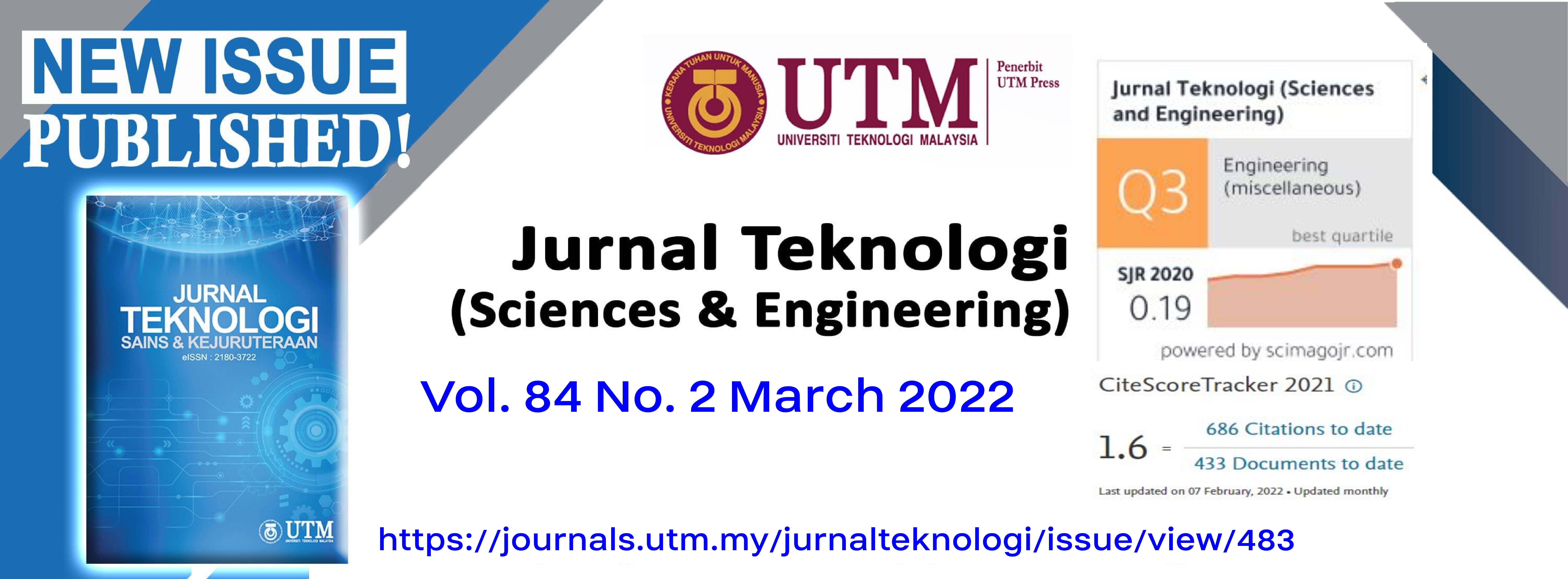A DISTRIBUTED MODEL OF HYDROLOGICAL AND SEDIMENT TRANSPORT IN THE UPNM CATCHMENT
DOI:
https://doi.org/10.11113/jurnalteknologi.v84.17482Keywords:
Sediment transport, small-scale catchment, soil erosion, sedimentation, UPNM catchmentAbstract
Sediment transport models in river basins have been developed over the years for various temporal and spatial scales. However, yet few models have been reported for small-scale catchment and still under investigation by many researchers. In this paper, a distributed model based on process was presented for evaluating transportation of sediment in a small catchment scale. The integration of distributed hydrological and sediment model was developed for simulate the soil erosion and sedimentation processes in the catchment area located at Universiti Pertahanan Nasional Malaysia (UPNM). The finding prevailed that the simulation of suspended sediment load over a period of four years gave a good significant result with an average Nash–Sutcliffe Efficiency (NSE) and a Correlation Coefficient (r) were of 0.60 and 0.78, respectively. Moreover, sensitivity analysis revealed that the suspended sediment load in the UPNM catchment was influenced by soil detachability over land (Kf). Overall, the outputs from the present model can be taken as input to predict the soil erosion and sedimentation processes in a small-scale catchment, especially in Malaysia such as in the UPNM.
References
Suif, Z., Fleifle, A., Yoshimura, C. and Saavedra, O. 2015. Spatio-temporal Patterns of Soil Erosion and Suspended Sediment Dynamics in the Mekong River Basin. Science of Total Environment. 568: 933-945.
Nearing, M. A., Foster, G.R., Lane, L. J. and Finckner, S. C. 1989. A Process-based Soil Erosion Model for USDA-Water Erosion Prediction Project Technology. Transactions of the American Society of Agricultural Engineers. 32: 1587-1593.
Morgan, R. P. C., Quinton, J. N. and Rickson, R. J. 1993. EUROSEM Version 3.1 a User Guide. Silsoe College, Cranfield University, Silsoe, Bedford, UK, 83.
Pfannerstill, M., Guse, B., Reusser, D. and Fohrer, N. 2015. Process Verification of a Hydrological Model using a Temporal Parameter Sensitivity Analysis. Hydrol. Earth Syst. Sci. 19: 4365-4376. Doi:10.5194/hess-19-4365-2015.
Suif, Z., Yoshimura, C., Ahmad, N., and Hul, S. 2018. Distributed Model of Hydrological and Sediment Transport Process in Mekong River Basin. International Journal of GEOMATE. 14(42): 134-139.
Li, L., Ni, J., Chang, F., Yue, Y., Frolova, N., F., Magritsky, D., Borthwick, A. G. L., Ciais, P., Wang, Y., Zheng, C., Walling, D. E. 2020. Global Trends in Water and Sediment Fluxes of the World’s Large Rivers. Science Bulletin. 65(1): 62-69.
Best, J. 2018. Anthropogenic Stresses on the World’s Big Rivers. Nat. Geosci. 12(1): 7-21.
Yang, D., Herath, S., Oki, T., and Musiake, K. 2001. Application of Distributed Hydrological Model in the Asian Monsoon Tropic Region with a Perspective of Coupling with Atmospheric Models. J. Meteorol. Soc. Jpn. 79: 373-385.
Torri, D., Sfalanga, M., and Delsette, M. 1987. Splash Detachment–runoff Depth and Soil Cohesion. Catena. 14: 149-155.
Brandt, C. J. 1989. The Size Distribution of Throughfall Drops Under Vegetation Canopies. Catena. 16: 507-524.
Brandt, C. J. 1990. Simulation of Size Distribution and Erosivity of Raindrops and Throughfall Drops. Earth Surf. Proc. Land. 15: 687-689.
Kabir, M. A., Dutta, D., and Hironaka, S. 2011. Process-based Distributed Modeling Approach for Analysis of Sediment Dynamics in a River Basin. Hydrol. Earth Syst. Sci. 15: 1307-1321.
DOI:10.5194/hess-15-1307-2011.
Habib-ur-Rehman, M. and Naeem Akhtar, M. 2004. Development of Regional Scale Soil Erosion And Sediment Transport Model; Its Calibration and Validations. 69th Annual Session. Proceedings of Pakistan Engineering Congress, Lahore, Pakistan. April, 231-245.
Morgan, R. P. C., Quinton, J. N., Smith, R. E., Govers, G., Poesen, W. A., Auerswald, K., Chisci, G., Torri, D., and Styczen, M. E. 1998. The European Soil Erosion Model (EU-ROSEM): A Dynamic Approach for Predicting Sediment Transport from Fields and Small Catchments. Earth Surf. Proc. Land. 23: 527-544.
Govers, G. 1990. Empirical Relationships for the Transport Capacity of Overland Flow. Erosion, Transport and Deposition Processes. IAHS Publ. 189: 45-63.
Duan, Q., Soorooshian, S., and Gupta, V. 1992. Effective and Efficient Global Optimization for Conceptual Rainfall–runoff Models. Water Resour. Res. 28: 1015-1031.
Nash, J. E. and Sutcliffe, J. V. 1970. River Flow Forecasting through, Part I: A Conceptual Models Discussion of Principles. J. Hydrol. 10: 282-290.
Sok, T., Oeurng, C., Kaing, V., Sauvage, S., Kondolf, G. M. and Pérez, J. M. S. 2021. Assessment of Suspended Sediment Load Variability in the Tonle Sap and Lower Mekong Rivers, Cambodia. Catena. 202: 105291.
Doi: 10.1016/j.catena.2021.105291.
Binh, D. V., Kantoush, S. and Sumi, T. 2020. Changes to Long-term Discharge and Sediment Loads in the Vietnamese Mekong Delta Caused by Upstream Dams. Geomorphology. 353: 107011.
Doi: 10.1016/j.geomorph.2019.107011.
Suif, Z., Razak, M. A. A. A. and Ahmad, N. 2018. Predicting of Soil Erosion with Regarding to Rainfall Erosivity and Soil Erodibility. AIP Conference Proceedings. 1930: 020054.
Doi: 10.1063/1.5022948.
Suif, Z., Yoshimura, C., Saavedra, O., Ahmad, N. and Hul, S. 2017. Suspended Sediment Dynamics Changes in Mekong River Basin: Possible Impacts of Dams and Climate Change. International of GEOMATE. 12(34): 140-145.
Swarnkar, S., Tripathi, S. and Sinha, R. 2021. Understanding Hydrogeomorphic and Climatic Controls on Soil Erosion and Sediment Dynamics in Large Himalayan basins.
Science of The Total Environment. 795: 148972.
Doi: 10.1016/j.scitotenv.2021.148972.f.
Downloads
Published
Issue
Section
License
Copyright of articles that appear in Jurnal Teknologi belongs exclusively to Penerbit Universiti Teknologi Malaysia (Penerbit UTM Press). This copyright covers the rights to reproduce the article, including reprints, electronic reproductions, or any other reproductions of similar nature.
















